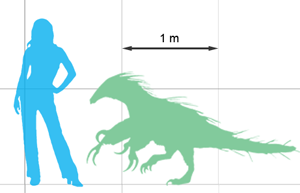home > natural history
Beipiaosaurus inexpectus
"surprising Beipiao lizard "

Beipiaosaurus was one of the first feathered dinosaurs found in the Yixian Formation of Liaoning, China, and is still the heaviest known (it used to be the longest, but Sinocalliopteryx took that title). One of the bizarre segnosaurs, Beipiaosaurus was a primitive member of the long-necked, herbivorous, giant-clawed theropod group that included the gigantic Therizinosaurus. In fact, Beipiaosaurus was the final straw in the longstanding debate over whether segnosaurs were theropods or some werid, late-surviving group of prosauropod-ornithischian missing links. It showd unmistakable theropod characterisitcs, and in facthelp pin segnosaurs down even further as probable close relatives of the oviraptors.
The first specimen of Beipiaosaurus was pretty poorly preserved (and prepared), with only bits of the skull and a halo of protofeathers that appeared similar to the downy fibers found in the most primitive feathered dinosaurs like Sinosauropteryx, which lived along side Beipiaosaurus. Another specimen described in 2008 not only preserved a complete (though curshed) skull, but a dense covering of extremely long, apparently stiffened monofilament feathers. The apparently simple structures may actually be modified from the more advanced, vaned feathers seen in oviraptors and modern birds. The scientists who studied the specimen concluded they must be for display, though the way they emerge from an undercoat of downy protofeathers as secondary "guard hair" like bristles is a bit more akin to a porcupine than a peacock. Further preparation work on the type specimen revealed more of these feathers on the tail, and in the drawing this is reproduced pretty much to the quill. All in all, a very different picture of therizinosaurs has emerged based on this find, as most reconstructions don't give them a dual-layered, very heavy coat of feathers.
Note that the feathers would probably be a bit more form fitting along the neck and back. I'm operting under the authers' assumption that they were at least partly for display, and here the creature has it's hackles raised to warn off intruders into its territory.
The length of the tail is unknown in this species, and is the most speculative part of the drawing. More primitive therizinosaurs, like Falcarius, have very long tails typical of Mesozoic coelurosaurs. More advanced forms, however, have highly reduced tails. I restored the tail of Beipiaosaurus at around mid-length between the two forms, a little on the shorter side. A reconstruction with a shorter tail can be seen in the scale chart to the right. Only more complete specimens will be able to show how long the tail was in this transitional species.
For more on Beipiaosaurus, see the Wikipedia article I helped edit.
Image Details:
Media: Graphite, digital coloring in Adobe Photoshop CS using WACOM Graphire 3
License:
Creative Commons Attribution-Share Alike 3.0
You are free to Share (transmit, copy, and distribute) and to Remix (adapt or modify) the images on this page Under the following conditions: You must Attribute the work by giving written credit to Matt Martyniuk and linking to this Web site: http://www.azhdarcho.com (but not in any way that suggests that they endorse you or your use of the work).
For any reuse or distribution, you must make clear to others the license terms of this work. The best way to do this is with a link to this web page.Any of the above conditions can be waived if you get permission from the copyright holder. Nothing in this license impairs or restricts the author's moral rights.
DESCRIPTION
Length: 2.2m (7.3ft)
Weight: 85kg (187lbs)
Location: Yixian Fomration, Liaoning, China (125ma)
Time: Barremian age, Lower Cretaceous (25 Ma)
CLASSIFICATION
Kingdom: Animalia
Phylum: Chordata
Class: Stem-Aves
Order: Segnosauria
Superfamily: Therizinosauroidea
Genus: Beipiaosaurus
Species: B. inexpectus
SYSTEMATICS
Sauropsida
Diapsida
Archosauria
Ornithosuchia
Dinosauria
Theropoda
Coelurosauria
Maniraptora
Therizinosauria
